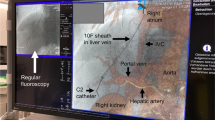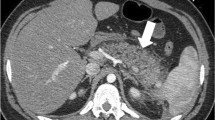Abstract
This review focuses on ultrasonography (US) to diagnose patients with complications in portal hypertension. Clinicians first use US to evaluate patients with suspected portal hypertension, because US is quick, simple, and radiation free. US is necessary for grading and performing paracentesis for ascites. Doppler US-based detection of reverse splanchnic vein flow or the presence of a spontaneous portosystemic shunt is highly specific in patients with cirrhosis. Since it is important to estimate spleen size in patients with portal hypertension, spleen size is usually measured by US. Spleen volume can be more accurately measured with 3D-US. Estimation of viable residual splenic volume after partial splenic embolization should be limited to cases with total splenic volume less than 1000 ml. Portal vein thrombosis is often detected during the US examination performed when symptoms first appear or during the follow-up. Two-dimensional transthoracic echocardiography is an excellent noninvasive screening test in patients with pulmonary portal hypertension who can undergo it. By measuring the maximum and minimum diastolic blood flow velocities in the renal arteries using renal color Doppler US, the pulsatility index (PI) and resistive index (RI) can be calculated. The PI and RI in cirrhotic patients were significantly higher than those in healthy subjects and patients with chronic hepatitis, and showed a significant positive correlation with the Child–Pugh Score. In conclusion, US is an essential tool for the diagnosis and treatment of patients with portal hypertension.











Similar content being viewed by others
Abbreviations
- US:
-
Ultrasonography
- CE-US:
-
Contrast-enhanced US
- PS:
-
Portosystemic shunts
- PVT:
-
Portal vein thrombosis
- PVTT:
-
Portal venous tumor thrombosis
- HVPG:
-
Hepatic venous pressure gradient
- CSPH:
-
Clinically significant portal hypertension
- PoPH:
-
Pulmonary portal hypertension
- HRS:
-
Hepatorenal syndrome
- SBP:
-
Spontaneous bacterial peritonitis
- UVSs:
-
Umbilical vein shunts
- MSs:
-
Mesenteric shunts
- CT:
-
Computed tomography
- SI:
-
Splenic index
- VOCAL:
-
Virtual organ computer-aided analysis
- ICCs:
-
Interclass correlation coefficients
- PSE:
-
Partial splenic embolization
- RHC:
-
Right-sided heart catheterization
- TTE:
-
Transthoracic echocardiography
- RVSP:
-
Right-ventricular systolic pressure
- PASP:
-
Pulmonary artery systolic pressure
- PI:
-
Pulsatility index
- RI:
-
Resistive index
- BUN:
-
Blood urea nitrogen
- Cr:
-
Creatinine
References
European Association for the Study of the Liver. EASL Clinical Practice Guidelines for the management of patients with decompensated cirrhosis. J Hepatol. 2018;69:406–60.
Ginés P, Quintero E, Arroyo V, et al. Compensated cirrhosis: natural history and prognostic factors. Hepatology. 1987;7:122–8.
Moore KP, Wong F, Gines P, et al. The management of ascites in cirrhosis: report on the consensus conference of the International Ascites Club. Hepatology. 2003;38:258–66.
Lin CH, Shih FY, Ma MHM, et al. Should bleeding tendency deter abdominal paracentesis? Dig Liver Dis. 2005;37:946–51.
Park SW, Ko SY, Yoon SY, et al. Transcatheter arterial embolization for hemoperitoneum: unusual manifestation of iatrogenic injury to abdominal muscular arteries. Abdom Imaging. 2011;36:74–8.
Lipinski M, Saborowski M, Heidrich B, et al. Clinical characteristics of patients with liver cirrhosis and spontaneous portosystemic shunts detected by ultrasound in a tertiary care and transplantation center. Scand J Gastroenterol. 2018;53:1107–13.
Martínez-Noguera A, Montserrat E, Torrubia S, et al. Doppler in hepatic cirrhosis and chronic hepatitis. Semin Ultrasound CT MR. 2002;23:19–36.
Procopet B, Berzigotti A. Diagnosis of cirrhosis and portal hypertension: imaging, non-invasive markers of fibrosis and liver biopsy. Gastroenterol Rep. 2017;5:79–89.
Simón-Talero M, Roccarina D, Martínez J, et al. Association between portosystemic shunts and increased complications and mortality in patients with cirrhosis. Gastroenterology. 2018;154:1694–705.
Dömland M, Gebel M, Caselitz M, et al. Comparison of portal venous flow in cirrhotic patients with and without paraumbilical vein patency using duplex-sonography. Ultraschall Med. 2000;21:165–9.
von Herbay A, Frieling T, Häussinger D. Color Doppler sonographic evaluation of spontaneous portosystemic shunts and inversion of portal venous flow in patients with cirrhosis. J Clin Ultrasound. 2000;28:332–9.
Zardi EM, Uwechie V, Caccavo D, et al. Portosystemic shunts in a large cohort of patients with liver cirrhosis: detection rate and clinical relevance. J Gastroenterol. 2009;44:76–83.
Riehl J, Bongartz D, Nguyen H, et al. Spontaneous portasystemic shunt in liver cirrhosis: imaging with color-coded duplex ultrasonography. Ultraschall Med. 1997;18:272–6.
Sie A, Johnson MB, Lee KP, et al. Color Doppler sonography in spontaneous splenorenal portosystemic shunts. J Ultrasound Med. 1991;10:167–9.
Ohira M, Ishifuro M, Ide K, et al. Significant correlation between spleen volume and thrombocytopenia in liver transplant patients: a concept for predicting persistent thrombocytopenia. Liver Transpl. 2009;15:208–15.
Pockros PJ, Duchini A, McMillan R, et al. Immune thrombocytopenic purpura in patients with chronic hepatitis C virus infection. Am J Gastroenterol. 2002;97:2040–5.
Nagamine T, Ohtuka T, Takehara K, et al. Thrombocytopenia associated with hepatitis C viral infection. J Hepatol. 1996;24:135–40.
Peck-Radosavljevic M, Wichlas M, Zacherl J, et al. Thrombopoietin induces rapid resolution of thrombocytopenia after orthotopic liver transplantation through increased platelet production. Blood. 2000;95:795–801.
Yang JC, Rickman LS, Bosser SK. The clinical diagnosis of splenomegaly. West J Med. 1991;155:47–52.
Ishibashi H, Higuchi N, Shimamura R, et al. Sonographic assessment and grading of spleen size. J Clin Ultrasound. 1991;19:21–5.
Matsutani S, Kimura K, Ohto M, et al. Ultrasonography in the diagnosis of portal hypertension. In: Okuda K, Benhamou JP, editors., et al., Portal hypertension clinical and physiological aspects. Tokyo: Springer-Verlag; 1991. p. 197–206.
Sheth SG, Mani S, Tamhankar H, et al. Spleen size in health and disease: a sonographic assessment. J Assoc Physicians India. 1995;43:182–4.
Hidaka H, Nakazawa T, Wang G, et al. Reliability and validity of splenic volume measurement by 3-D ultrasound. Hepatol Res. 2010;40:979–88.
Maddison FE. Embolic therapy of hypersplenism. Invest Radiol. 1973;8:280–1.
Yoshida H, Mamada Y, Taniai N, et al. Partial splenic embolization. Hepatol Res. 2008;38:225–33.
Hayashi H, Beppu T, Okabe K, et al. Therapeutic factor considered according to the preoperative splenic volume for a prolonged increase in platelet count after partial splenic embolization for liver cirrhosis. J Gastroenterol. 2010;45:554–9.
Hayashi H, Beppu T, Okabe K, et al. Risk factors for complications after partial splenic embolization for liver cirrhosis. Br J Surg. 2008;95:744–50.
Schlesinger AE, Edgar KA, Boxer LA. Volume of the spleen in children as measured on CT scans: normal standards as a function of body weight. Am J Roentgenol. 1993;160:1107–9.
Breiman RS, Beck JW, Korobkin M, et al. Volume determinations using computed tomography. Am J Roentgenol. 1982;138:329–33.
Lamb PM, Lund A, Kanagasabay RR, et al. Spleen size: how well do linear ultrasound measurements correlate with three-dimensional CT volume assessments? Br J Radiol. 2002;75:573–7.
Hidaka H, Wang G, Nakazawa T, et al. Total and viable residual splenic volume measurement after partial splenic embolization by three-dimensional ultrasound. J Med Ultrason. 2013;40:417–24.
Kawanaka H, Akahoshi T, Kinjo N, et al. Laparoscopic splenectomy with technical standardization and selection criteria for standard or hand-assisted approach in 390 patients with liver cirrhosis and portal hypertension. J Am Coll Surg. 2015;221:354–66.
Mahon D, Rhodes M. Laparoscopic splenectomy: size matters. Ann R Coll Surg Engl. 2003;85:248–51.
Patel AG, Parker JE, Wallwork B, et al. Massive splenomegaly is associated with significant morbidity after laparoscopic splenectomy. Ann Surg. 2003;238:235–40.
Northup PG, Garcia-Pagan JC, Garcia-Tsao G, et al. Vascular liver disorders, portal vein thrombosis, and procedural bleeding in patients with liver disease: 2020 Practice Guidance by the American Association for the Study of Liver Diseases. Hepatology. 2021;73:366–413.
Lisman T, Kamphuisen PW, Northup PG, et al. Established and new-generation antithrombotic drugs in patients with cirrhosis—possibilities and caveats. J Hepatol. 2013;59:358–66.
Maruyama H, Ishibashi H, Takahashi M, et al. Prediction of the therapeutic effects of anticoagulation for recent portal vein thrombosis: a novel approach with contrast-enhanced ultrasound. Abdom Imaging. 2012;37:431–8.
Lv Y, Han G, Fan D. Portopulmonary hypertension. Scand J Gastroenterol. 2016;51:795–806.
Krowka MJ, Swanson KL, Frantz RP. Portopulmonary hypertension: Results from a 10-year screening algorithm. Hepatology. 2006;44:1502–10.
Raevens S, Colle I, Reyntjens K, et al. Echocardiography for the detection of portopulmonary hypertension in liver transplant candidates: an analysis of cutoff values. Liver Transpl. 2013;19:602–10.
Cotton CL, Gandhi S, Vaitkus PT, et al. Role of echocardiography in detecting portopulmonary hypertension in liver transplant candidates. Liver Transpl. 2002;8:1051–4.
Colle I. Diagnosis of portopulmonary hypertension in candidates for liver transplantation: a prospective study. Hepatology. 2003;37:401–9.
Kim WR, Krowka MJ, Plevak DJ, et al. Accuracy of Doppler echocardiography in the assessment of pulmonary hypertension in liver transplant candidates. Liver Transpl. 2000;6:453–8.
Torregrosa M, Genesca J, Gonzalez A, et al. Role of Doppler echocardiography in the assessment of portopulmonary hypertension in liver transplantation candidates. Transplantation. 2001;71:572–4.
Hua R, Sun YW, Wu ZY, et al. Role of 2-dimensional Doppler echo-cardiography in screening portopulmonary hypertension in portal hypertension patients. Hepatobiliary Pancreat Dis Int. 2009;8:157–61.
Auletta M, Oliviero U, Iasiuolo L, et al. Pulmonary hypertension associated with liver cirrhosis: an echocardiographic study. Angiology. 2000;51:1013–20.
Ko JM, Ahn MI, Han DH, et al. Dynamic CT and MRA findings of a case of portopulmonary venous anastomosis (PPVA) in a patient with portal hypertension: a case report and review of the literature. Acta Radiol. 2011;52:566–9.
Krowka MJ. Portopulmonary hypertension: diagnostic advances and caveats. Liver Transpl. 2003;9:1336–7.
Colle IO, Moreau R, Godinho E, et al. Diagnosis of portopulmonary hypertension in candidates for liver transplantation: a prospective study. Hepatology. 2003;37:401–9.
Koda M, Murawaki Y, Kawasaki H. Renovascular resistance assessed by color Doppler ultrasonography in patients with chronic liver diseases. J Gastroenterol Hepatol. 2000;15:1424–9.
Platt JF, Ellis JH, Rubin JM, et al. Renal duplex Doppler ultrasonography: a noninvasive predictor of kidney dysfunction and hepatorenal failure in liver disease. Hepatology. 1994;20:362–9.
Bardi A, Sapunar J, Oksenberg D, et al. Intrarenal arterial doppler ultrasonography in cirrhotic patients with ascites, with and without hepatorenal syndrome. Rev Med Chil. 2002;130:173–80.
Kastelan S, Ljubicic N, Kastelan Z, et al. The role of duplex-doppler ultrasonography in the diagnosis of renal dysfunction and hepatorenal syndrome in patients with liver cirrhosis. Hepatogastroenterology. 2004;51:1408–12.
Acknowledgements
We thank Hitoshi Maruyama, MD, PhD, Department of Gastroenterology, Juntendo University, for advice on writing the manuscript, and Robert E. Brandt, Founder, CEO, and CME, of MedEd Japan, for editing and formatting the manuscript.
Funding
The authors disclose no sources of funding.
Author information
Authors and Affiliations
Corresponding author
Ethics declarations
Conflict of interest
The authors declare no conflicts of interest.
Ethical statements
All procedures followed were in accordance with the ethical standards of the responsible committee on human experimentation (institutional and national) and with the Helsinki Declaration of 1964 and later versions. Additional informed consent was obtained from all patients for which identifying information is included in this article.
Additional information
Publisher's Note
Springer Nature remains neutral with regard to jurisdictional claims in published maps and institutional affiliations.
About this article
Cite this article
Hidaka, H., Uojima, H. Ultrasonography in the diagnosis of complications in patients with portal hypertension. J Med Ultrasonics 49, 347–358 (2022). https://doi.org/10.1007/s10396-021-01158-3
Received:
Accepted:
Published:
Issue Date:
DOI: https://doi.org/10.1007/s10396-021-01158-3




